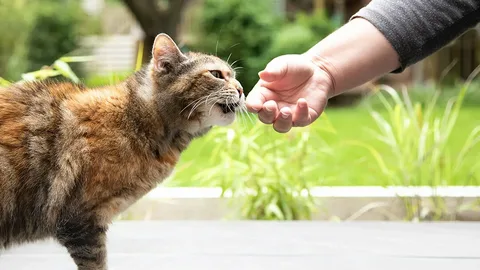Cats have almost the same brain-to-body mass ratio as apes and thousands more brain neurons than dogs. This makes them great at learning and problem-solving. Many people think you can’t train your cat, but that’s a myth.
Cat owners often hear: “Cats are too independent” or “They don’t care about pleasing humans.” These false beliefs prevent us from unlocking their true potential. With the right approach and positive reinforcement, your cat can learn new behaviors.
Short training sessions of 5-10 minutes can lead to amazing results. Using clicker training or food rewards helps cats learn faster than expected. Want to train your cat and build a stronger bond? Let’s explore proven methods to make training fun and effective.
Understanding Your Cat's Trainability
New studies have revealed some amazing things about how cats think and learn. Cats can link images with words faster than 14-month-old human babies. They need just two 9-second lessons, while babies need four 15-second lessons. Cats also show impressive mental skills. They understand when objects still exist even when hidden, and their memory can last up to 10 years.
The science behind cat learning
The way cats learn is quite sophisticated. They learn by watching and experiencing things around them. Research shows that adult cats are as smart as a 2-year-old human toddler. Cats pick up information by watching other cats, animals, and humans. The sort of thing I love is how cats can connect words with images naturally, without any reward training. They simply listen in on human conversations.
Myths about cat training debunked
People often say cats are too independent or stubborn to train. In spite of that, studies show they respond well to positive reinforcement. Some think cats only care about food rewards. The truth is many cats actually prefer human attention over food as motivation. A cat holds the world record for performing 26 tricks in one minute. Yes, it is true that cats can learn complex behaviors.
How cats differ from dogs in training
Both cats and dogs learn well, but they need different training methods because of their backgrounds. Dogs are pack animals, but cats grew up as lone hunters, which changes how we need to train them. Cats see their owners as equals instead of pack leaders. This affects how they respond to training.
Cats need shorter training sessions, usually 5-10 minutes, because their attention spans differ from dogs. It also turns out that cats might not always respond to training tools like clickers paired with food the same way dogs do. Dogs do equally well with just food or food with clickers.
These differences help trainers create better strategies. Cats respond better to enriched environments and personal motivation techniques. Their love of territory and independent nature means trainers need patience. The approach should focus on mutual respect rather than the eagerness to please that dogs typically show.
Essential Tools and Preparation for Cat Training
Proper preparation and the right tools lay the foundation for successful cat training. Let’s explore what you need to create a good learning environment for your feline friend before you start training.
Creating the ideal training environment
Pick a quiet area in your home away from distractions. Your cat’s focus can be affected by family members, other pets, and background noises. Keep your pets in separate rooms during training sessions if you have multiple pets. A low-traffic space where your cat feels safe and comfortable works best.
Training tools you'll need
Essential training equipment includes:
- A clicker with wrist strap – Pick one that makes a soft sound to avoid startling your cat
- High-value treats – Small, low-calorie options your cat loves (about pea-sized)
- Target stick – An extendable version with a built-in clicker works best for cats
- Treat pouch – Should be easy to clean and quick to access during training
- Training mat – Helps teach “stay” commands and establishes designated spots
Setting realistic expectations
Timing and approach are vital for successful training. Keep sessions under 15 minutes to maintain your cat’s focus. Work on one skill until mastery before moving to the next.
Note that cats learn differently from dogs. Cats evolved as solitary hunters and view their owners as equals instead of pack leaders, so training needs patience and consistency. Your cat’s mood matters before starting – training works best when they’re happy and between meals.
Set clear goals before you begin, but stay flexible with your expectations. While some cats master simple commands within 2-3 sessions, others need more time. Some cats take 30-40 seconds to process and execute new tricks.
Focus on redirecting unwanted behaviors rather than punishment. Successful training builds on positive reinforcement and clear communication between you and your cat. The right tools and consistent practice will create an enriching learning experience for your feline companion.
Basic Cat Training Techniques That Work
Cat training success depends on building trust and encouraging good behavior. Let’s look at proven ways to make training work and keep it fun for both you and your cat.
Positive reinforcement fundamentals
Cats respond best to positive reinforcement. This means giving rewards within 3 seconds when they do something right. You can use treats, catnip, play time, or gentle grooming as rewards. Your cat needs a stress-free environment, so skip any punishment that could cause fear or health problems.
Clicker training for beginners
A clicker creates clear signals between you and your cat. Start by “charging” the clicker – click once and give a treat right away. Your cat will soon connect clicks with rewards, helping you mark good behavior exactly when it happens. The clicker really helps catch quick actions like “high five” at just the right moment.
Teaching your cat to respond to their name
Pick a quiet spot about 1.5 feet from your cat to start name training. Say their name clearly and reward them as soon as they look at you. Each training session should last 2-3 minutes. Your cat will learn the basics, then you can add distance and try different positions. Remember to:
- Save their name just for training at first
- Keep rewards consistent
- Move to new spots once they know the basics
Litter box training essentials
Most cats learn to use their litter box naturally. The box should be in a quiet spot away from food and water. Add about 2 inches of litter so your cat can dig and cover properly. You’ll get the best results if you:
- Get a box 1.5 times your cat’s length
- Take your cat to the box after meals and naps
- Clean daily and wash the whole box weekly
- Give praise right after they use it
Staying consistent matters in all aspects of training. Match your cat’s natural schedule and priorities while keeping sessions short and focused. With some patience and the right approach, you’ll find cats can learn new behaviors quite well.
Advanced Training: Teaching Your Cat Impressive Tricks
Your cat can advance to impressive tricks after learning simple commands. Through consistent practice and proper techniques, cats can learn complex behaviors that show their remarkable intelligence.
How to train your cat to sit on command
Hold a treat close to your cat’s nose, then slowly lift it up and back toward their tail. Your cat will move into a sitting position naturally as they follow the treat with their eyes. Say “yes” immediately and give them the reward. You should introduce a hand signal by flicking your wrist upward after several successful attempts. Training sessions should stay under three minutes, with three sessions each day.
Teaching your cat to come when called
Choose a unique sound or phrase that is different from everyday conversation. Give the call and follow it with an enticing reward. Offer the treat within two seconds once your cat approaches. You can increase distance gradually and practice in different rooms. Note that you should maintain a 10-to-1 ratio – all but one of these responses should result in something less appealing like grooming.
High-five and paw training techniques
Hold a treat in a closed hand near the floor to start. Say “yes” and give them a reward when your cat touches your hand with their paw. Raise the height of your hand gradually until they lift their paw consistently. Present an open palm without treats next and reward successful touches. The final step is to position your palm facing outward above their head for the classic high-five position.
Training your cat to walk on a leash
Use a harness, never a collar alone. Let your cat find the harness indoors first, using Feliway spray or catnip creates positive associations. Attach the leash and let them drag it around once they feel comfortable. This process is fundamentally different from dog walking – you should follow your cat’s lead instead of directing them. Give rewards for calm behavior and never force movement. Enclosed spaces work best before heading outdoors.
Conclusion
Research shows cats have remarkable learning abilities that match a two-year-old child’s cognitive skills. Our research has shown that successful cat training depends on understanding feline psychology. The right environment and proper tools make all the difference.
Positive reinforcement is the life-blood of cat training that works. Quick training sessions paired with instant rewards help build trust and encourage good behavior. Teaching simple commands or advanced tricks like high-fives and leash walking needs patience and consistency.
Note that cats learn differently and move at their own speed. Your cat might pick up new tricks in days, while others need weeks to practice. Success comes from celebrating small wins rather than comparing progress. These expert tips and techniques will help you find joy in building a deeper connection with your cat through training.

